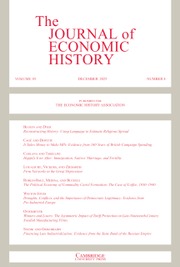Article contents
Institutional Change, Compensating Differentials, and Accident Risk in American Railroding, 1892–1945
Published online by Cambridge University Press: 03 March 2009
Abstract
The labor markets in the railroad industry went through extensive institutional changes between 1890 and 1945. Federal laws increased railroad employers' liability for workplace accidents in several stages. Unions expanded to cover more occupations. The federal government set railroad wages during World War I and then mediated and arbitrated a large number of collective bargaining disputes between 1920 and 1945. We examine how these changes in institutions affected compensating differentials for fatal and nonfatal accident risk. The increasing role of unionization and government intervention coincided with a decline in the size of compensating differentials.
Information
- Type
- Articles
- Information
- Copyright
- Copyright © The Economic History Association 1993
References
Clark, Lindley D., “The Legal Liability of Employers for Injuries to their Employees in the United States,” in U.S. Department of Commerce and Labor, Bulletin of the Bureau of Labor (Washington, DC, 1908), vol. 14, pp. 1–120.Google Scholar
Clark, Lindley D., “Recent Action Relating to Employers' Liability and Workmen's Compensation,” U.S. Department of Commerce and Labor, Bulletin of the Bureau of Labor No. 90 (Washington, DC, 1910).Google Scholar
Fairris, David, “Compensating Wage Differentials in the Union and Nonunion Sectors,” Industrial Relations, 28 (Fall 1989), pp. 356–72.CrossRefGoogle Scholar
Fishback, Price, Soft Coal, Hard Choices: The Economic Welfare of Bituminous Coal Miners, 1890–1930 (New York, 1992).CrossRefGoogle Scholar
Fishback, Price, and Kantor, Shawn, “‘Square Deal’ or Raw Deal? Market Compensation for Workplace Disamenities, 1884–1903,” this Journal, 52 (December 1992), pp. 826–48.Google Scholar
Fishback, Price, and Kantor, Shawn, “Did Workers Gain from the Passage of Workers' Compensation Laws?” (Working Paper, University of Arizona Department of Economics, Tucson, 1993).Google Scholar
Gorden, Kenneth, “Accident Rates and Wages on U.S. Class-I Railroads” (Ph.D. diss., University of Chicago, 1973).Google Scholar
Hatton, Timothy, and Williamson, Jeffrey, “Unemployment, Implicit Contracts, and Wage Differentials: Michigan in the 1890s,” this Journal, 51 (September 1991), pp. 605–32.Google Scholar
Jones, Harry E., Railroad Wages and Labor Relations, 1900–1952: An Historical Survey and Summary of Results (1953).Google Scholar
Kim, Seung-Wook, “Accident Risk and Railroad Worker Compensation: An Historical Study, 1880–1945” (Ph.D. diss., University of Georgia, Athens 1988).Google Scholar
Kniesner, Thomas, and Leeth, John, “Compensating Wage Differentials for Injury Risk in Australia, Japan, and the United States,” Journal of Risk and Uncertainty, 4 (June 1991), pp. 75–90.CrossRefGoogle Scholar
Krueger, Alan B., and Summers, Lawrence, “Efficiency Wages and the Inter-industry Wage Structure,” Econometrica, 56 (March 1988), pp. 259–93.Google Scholar
Landes, William, and Posner, Richard, The Economic Structure of Tort Law, (Cambridge, MA, 1987).CrossRefGoogle Scholar
Minnesota Bureau of Labor, Industries and Commerce, Twelfth Annual Report, 1909–1910 (Minneapolis, 1910).Google Scholar
Moore, Michael, and Viscusi, W. Kip, Compensation Mechanisms for Job Risks: Wages, Workers' Compensation and Product Liability (Princeton, 1990).CrossRefGoogle Scholar
Neill, Chas. P., “Mediation and Arbitration of Railway Labor Disputes in the United States,” U.S. Department of Commerce and Labor, Bulletin of the Bureau of Labor No. 98 (Washington, DC, 1912).Google Scholar
Oi, Walter, “An Essay on Workmen's Compensation and Industrial Safety,” in Barth, Peter S. et al. , eds., Supplemental Studies for the National Commission on State Workman's Compensation Laws (Washington, DC, 1973), vol. 1, pp. 41–106.Google Scholar
Perlman, Mark, The Machinists: A New Study in American Trade Unionism (Cambridge, MA, 1961).Google Scholar
Schrieber, David, The Legislative History of the Railroad Retirement and Railroad Unemployment Insurance Systems (Washington, DC, 1978).Google Scholar
Smith, Adam, An Inquiry into the Nature and Cause of the Wealth of Nations (New York, 1937).Google Scholar
Stole, Lars, “The Economic Effects of Liability Rules on Railroad Employee Accidents: 1890–1970,” (Working paper, Graduate School of Business, University of Chicago, 1992).Google Scholar
Thaler, Richard, and Rosen, Sherwin, “The Value of Saving a Life: Evidence from the Labor Market,” in Terleckyj, N., ed., Household Production and Consumption (New York, 1976), pp. 265–98.Google Scholar
U.S. Bureau of the Census, Historical Statistics of the United States: Colonial Times to 1970 (Washington, DC, 1975).Google Scholar
U.S. Commissioner of Labor, Workmen's Insurance and Benefit Funds, 23rd Annual Report of the Commissioner of Labor, 1908 (Washington, DC, 1909).Google Scholar
U.S. Interstate Commerce Commission, Accident Bulletin (Washington, DC, various years).Google Scholar
U.S. Interstate Commerce Commission, Statistics of Railways in the United States for the Year Ending June 30 (Washington, DC, various years).Google Scholar
U.S. Interstate Commerce Commission, Wage Statistics—Class I Steam Road in the United States for the Twelve Months Ended December 31 (Washington, DC, various years).Google Scholar
U.S. Senate. Cost of Railroad Employee Accidents, 1932. U.S. Senate Document No. 68, 74th Congress, 2d sess., 1935.Google Scholar
U.S. Senate, The Report of the Employers' Liability and Workmen's Compensation Commission, vol. I. U.S. Senate Document No. 338, 62d Congress, 2d sess., 1912.Google Scholar
Viscusi, W. K., “Wealth Effects and Earnings Premiums for Job Hazards,” Review of Economics and Statistics, 60 (Aug. 1978), pp. 408–16.Google Scholar
- 13
- Cited by

